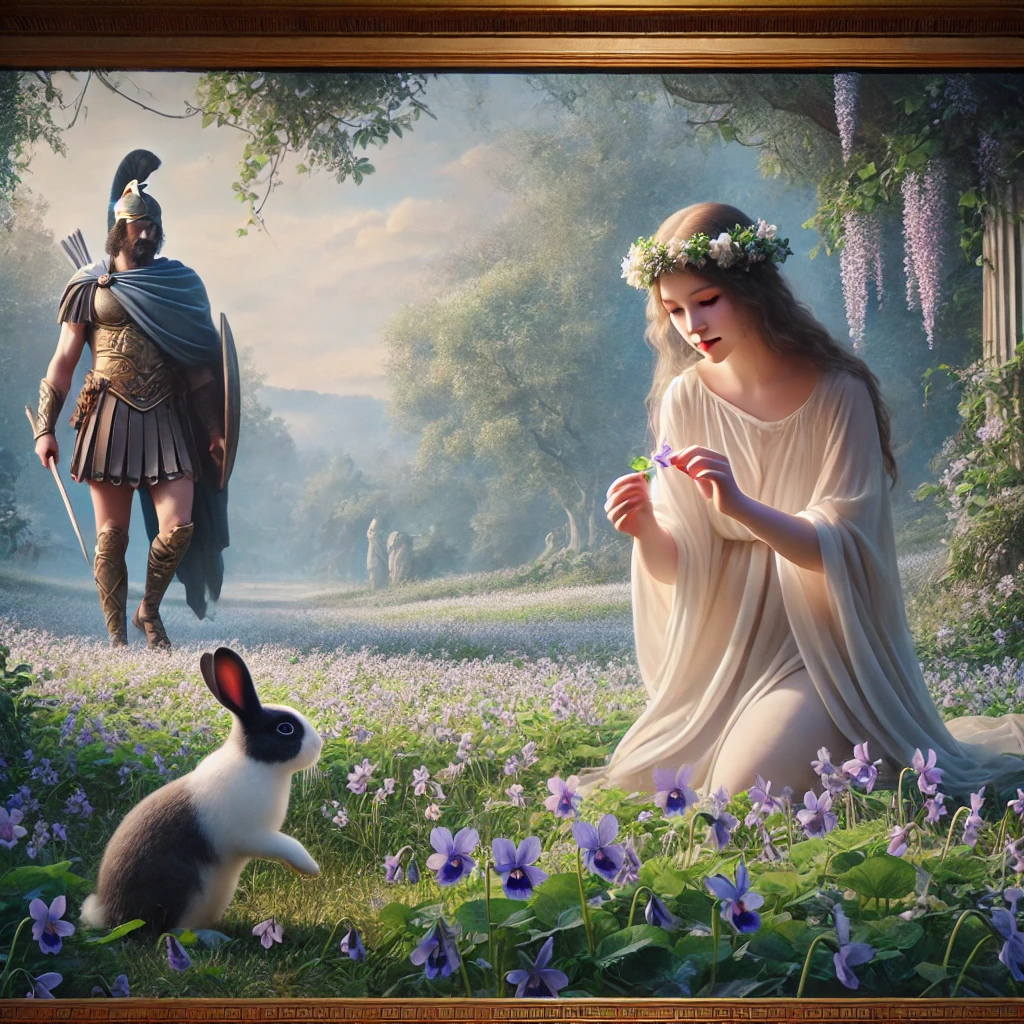Violets, with their delicacy and intense color, are more than just ordinary flowers. They carry the symbolism of a profound and transformative story that unites love and the power of renewal. At the heart of Greek mythology, we find the young goddess Persephonedaughter of Demeterand his unexpected fate alongside Hadesthe dark god of the underworld. This tale, which begins with a forced separation, evolves into a story of love and transformation - and violets play an essential role in this journey.
Index
Persephone and the Violets
Persephone was known for her beauty, purity and joy as she strolled through the flowery fields of the Earth, picking flowers and enchanting everyone around her. She was loved by her mother, Demeter, the goddess of the harvest and fertility, who watched over her daughter with extreme devotion.
One day, while Persephone was harvesting violets in a lush field, the ground beneath their feet began to tremble. Suddenly, a fissure opened up and from it emerged Hadesthe god of the underworld. He had been watching her for a long time, fascinated by the light and vitality she emanated, something that was lacking in his world of shadows.
Hades, driven by a deep desire and a love he believed to be impossible, took Persephone in his golden chariot and carried her off to the realm of the dead, where he wanted her to be his queen. For Persephone, it seemed like a nightmare. She was separated from everything she loved, from her mother, from the sunlight, from the Earth she knew so well.
For the first few days, Persephone was overcome with sadness. But as time went by, she began to notice something different about Hades. Although he was the god of the underworld, he wasn't the cruel tyrant that many imagined. He looked after her with respect, offering her the throne at his side and a power she had never known. Hades, for his part, didn't just see Persephone as his prisoner, but as someone with whom he could share his world - his darkness and, paradoxically, his inner light.
Persephone began to understand that although the underworld was dark, there was a subtle beauty there. She was no longer just the daughter of Demeter; now she had the opportunity to be a powerful queen, capable of guiding souls and bringing balance between life and death.
Over time, a deep and transforming love began to blossom between Persephone and Hades, a love that transcended their initial fear and was based on mutual understanding and respect. She realized that, in the realm of the dead, she could be both light and shadow - the goddess who ruled life, but also death.
Meanwhile, on Earth, Demeter suffered deeply for the absence of her daughter, causing the crops to wither and the world to plunge into winter. Her grief caught the attention of Zeus, who intervened, making Hades agree to return Persephone to her mother for part of the year.
However, before returning to Earth, Persephone, already connected to the underworld, ate some pomegranate seeds, which linked her forever to the kingdom of Hades. So an agreement was made: Persephone would spend half the year with Hades, as queen of the underworld, and the other half with her mother, on Earth.
Every springWhen Persephone returns to the surface, the violets are the first to bloom, symbolizing her return and the renewal of life. But when winter comes and Persephone returns to Hades, the Earth goes into rest, awaiting her rebirth.

Symbolism of Violets in Myth
The violets play an important symbolic role in this myth, representing:
- Innocence and TransformationWhen Persephone picks the violets at the beginning of the tale, they symbolize her innocence and purity. However, as the story progresses, they also become a symbol of her transformation - from a sheltered young daughter to a powerful queen who rules both life and death.
- Impossible Love: The flowering of violets in spring marks Persephone's return to Earth, but it also carries the memory of her love for Hades - a love that, although forced at first, developed into something deep and lasting.
- RenaissanceThe violets, which bloom first after winter, represent the cycle of life, death and rebirth that Persephone embodies on her journey between the underworld and Earth.
Violets and the Cycle of the Seasons
This myth also serves as a metaphor for the cycle of the seasons. When Persephone is with Hades in the underworld, winter dominates the Earth - a period of rest and introspection. When she returns in spring, the world blooms again, bringing the promise of new life and opportunities.
Violets, which are the first flowers to bloom, represent the beginning of this cycle, symbolizing hope and rebirth. They remind us that, just as Persephone returns to Earth, we all go through cycles of change, where moments of darkness are followed by periods of light and renewal.
Conclusion
The myth of Persephone and the violets is a richly layered narrative that goes far beyond a simple kidnapping or tragedy. It tells us about the duality of life and death, light and darkness, and how the balance between these extremes is essential to the natural order of the world. Persephone's journey between the underworld and Earth reflects the cycle of the seasons and the need to accept the inevitable changes in our lives.
The violetsThe flowers, which appear both at the beginning of the story and in spring, represent more than Persephone's lost innocence. They symbolize rebirth after darkness, the ability to flourish even after the most difficult times. Just as Persephone learned to find her place in the underworld and on Earth, violets remind us that, even in the most challenging situations, there is always the possibility of transformation and renewal. Beauty can be found even in moments of darkness, and love, like that of Hades and Persephone, can emerge and grow in unexpected places.
In addition, the myth teaches us to respect the natural cycles of life - the passage of time, the arrival of winter and the rebirth of spring. Persephone is not just a goddess of the underworld; she is the perfect balance between the world of the living and the world of the dead. She reminds us that, like the seasons, we all go through periods of introspection, rest and renewal. It is in this cycle that we find our own strength and capacity for transformation.
Over the centuries, this tale has inspired rituals and spiritual practices, with violets being used to represent renewal, protection and inner strength. Incorporating violets into rituals or simply growing this flower at home can be a constant reminder of the beauty of transformation and the balance we should seek in our lives. Like Persephone, we all have the opportunity to blossom after times of darkness, bringing light and new life to our path.
I'm passionate about magic and spirituality, always looking for new knowledge about rituals, energies and the mystical universe. Here, I share magical practices and spiritual tips for those who want to connect more deeply with themselves and the world around them, all in a light and accessible way.








